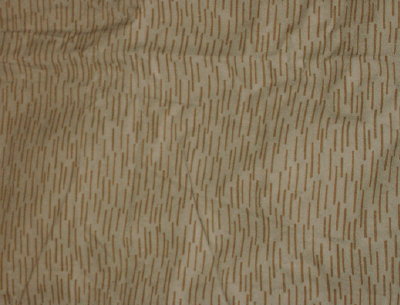|
NVA "Rain Pattern" Camouflage 1965-1990
|

NVA Rain Pattern Camouflage
|
 NVA Rain Pattern Camouflage |
|
In the mid-60’s the NVA initiated a complete redesign of the "Flächendruck" camouflage in conjunction with two of its Warsaw Pact allies Poland and Czechoslovakia. This new “Strichtarn” pattern featured olive brown vertical dashes imprinted over an olive green background giving the pattern the appearance of rain drops and hence the name “rain pattern”. Poland and Czechoslovakia adopted this pattern as well with each having slight national variations. The “Strichtarn” uniforms began to be issued in 1967 and came into widespread use over the next 2 years. The large existing stocks of "Flächendruck" uniforms were in many cases re-dyed black and re-tailored into utility or work uniforms for the NVA . Combat uniforms featuring the rain pattern camouflage were issued in summer and winter versions comprising a jacket and pant combination that could be worn alone or over the drill uniform. Being a more practical modern uniform, the rain pattern combination was more dirt resistant and easier to maintain than the Spotch / Leaf Pattern uniform. As well, the “Strichtarn” uniforms were a more form fitting and comfortable design than the earlier "Flächendruck" camouflage. From the point of view of the economy-minded DDR, the new uniforms were much less expensive to mass produce. The “Strichtarn” uniform was a true BDU (Battle-Dress Utility) in that is was expressly designed as a complete uniform for the NVA combat soldier. This combination went through small modifications over its 25-year history, but essentially remained the same uniform from 1965. The summer combination jacket featured 7 large pockets (4 front, 2 sleeve and an interior ‘hidden’ pistol pocket) while the pants featured 5 pockets ( 2 ‘slash’ waist pockets, 2 “cargo” thigh pockets and 1 rear pocket). Wrist and ankle cuffs included button and tab closures. The lined winter combination jacket featured 7 large pockets (4 front, 2 sleeve and an interior pocket). It also had a detachable artificial fur collar that could be attached or removed according to the season and standing orders. This fur collar was issued in 3 color variations that included green-grey for NVA officers, dark grey for NVA NCOs and enlisted personnel, and black for Volksmarine personnel. The lined pants included 3 pockets (2 ‘slash’ waist pockets and one rear pocket). Both of these items featured elasticized knit cuffs. The winter and summer combat uniforms also included attachment points for subdued olive green shoulderboard rank system. In 1986, a new rank system was devised that featured a square cloth rank patch on the left sleeve in place of shoulderboards. This new system was to be utilized supposedly by flight and technical personnel only, but combat uniforms were developed with the rank patch system for tank (Panzer) troops and paratroops (Fallschirmjäger) as well as the regular infantry personnel. As part of the complete camouflage system, the NVA also integrated other camouflage field equipment into the uniform. This included the rain pattern camouflage groundsheet / poncho, helmet cover, fatigue cap, assault pack, canteen, entrenching tool carrier, AK-47/74 ammunition pouch, RPD/RPD drum magazine pouch, RPK magazine pouch, officer's briefcase, RPG carrier/backpack, mine detector equipment carrier, paratrooper backpack, radio carrier, gas mask bag, grenade pouch, LBE web gear (load bearing equipment), and pistol holster. The fatigue cap, LBE web gear, pistol holster, grenade pouch, and gasmask bag were only very late issue items and consequently did not see much service. These late issue items also included a redesigned AK-47/74 ammunition pouch and entrenching tool carrier. Apart from the fatigue cap, all of the 7 late issue field gear items (LBE, canteen, entrenching tool carrier, AK-47/74 ammunition pouches, pistol holster, grenade pouch, and gasmask bag) feature green metal attachment fittings and green nylon web releases. These 7 late issue items have been designated as UTV equipment. |